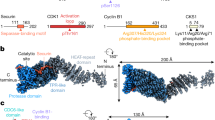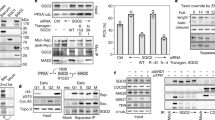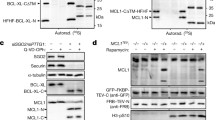Abstract
Separase is a protease that triggers chromosome segregation at anaphase onset by cleaving cohesin, the chromosomal protein complex responsible for sister chromatid cohesion1,2. After anaphase, cells exit from mitosis; that is, they complete downregulation of cyclin-dependent kinase activity, undergo cytokinesis and enter G1 of the next cell cycle. Here we show that separase activation at the onset of anaphase is sufficient to promote release from the nucleolus and activation of the budding yeast phosphatase, Cdc14, a key step in mitotic exit3,4,5. The ability of separase to activate Cdc14 is independent of its protease function but may involve promoting phosphorylation of the Cdc14 inhibitor Net1. This novel separase function is coregulated with its proteolytic activity by the separase inhibitor securin. This helps to explain the coupling of anaphase and mitotic exit — after securin degradation at anaphase onset, separase cleaves cohesin to trigger chromosome segregation and concurrently uses a non-proteolytic mechanism to initiate mitotic exit.
This is a preview of subscription content, access via your institution
Access options
Subscribe to this journal
Receive 12 print issues and online access
$209.00 per year
only $17.42 per issue
Buy this article
- Purchase on Springer Link
- Instant access to full article PDF
Prices may be subject to local taxes which are calculated during checkout





Similar content being viewed by others
References
Uhlmann, F., Wernic, D., Poupart, M.-A., Koonin, E.V. & Nasmyth, K. Cleavage of cohesin by the CD clan protease separin triggers anaphase in yeast. Cell 103, 375–386 (2000).
Nasmyth, K. Segregating sister genomes: the molecular biology of chromosome separation. Science 297, 559–565 (2002).
Visintin, R., Hwang, E.S. & Amon, A. Cfi1 prevents premature exit from mitosis by anchoring Cdc14 phosphatase in the nucleolus. Nature 398, 818–823 (1999).
Shou, W. et al. Exit from mitosis is triggered by Tem1-dependent release of the protein phosphatase Cdc14 from nucleolar RENT complex. Cell 97, 233–244 (1999).
Bardin, A.J. & Amon, A. MEN and SIN: what's the difference? Nature Rev. Mol. Cell Biol. 2, 1–12 (2001).
Tinker-Kulberg, R.L. & Morgan, D.O. Pds1 and Esp1 control both anaphase and mitotic exit in normal cells and after DNA damage. Genes Dev. 13, 1936–1949 (1999).
Granot, D. & Snyder, M. Segregation of the nucleolus during mitosis in budding and fission yeast. Cell Motil. Cytoskeleton 20, 47–54 (1991).
Yeong, F.M., Lim, H.H., Wang, Y. & Surana, U. Early expressed Clb proteins allow accumulation of mitotic cyclin by inactivating proteolytic machinery during S phase. Mol. Cell. Biol. 21, 5071–5081 (2001).
Shirayama, M., Toth, A., Galova, M. & Nasmyth, K. APCCdc20 promotes exit from mitosis by destroying the anaphase inhibitor Pds1 and cyclin Clb5. Nature 402, 203–207 (1999).
Yeong, F.M., Lim, H.H., Padmashree, C.G. & Surana, U. Exit from mitosis in budding yeast: Biphasic inactivation of the Cdc28-Clb2 mitotic kinase and the role of Cdc20. Mol. Cell 5, 501–511 (2000).
Stegmeier, F., Visintin, R. & Amon, A. Separase, polo kinase, the kinetochore protein Slk19, and Spo12 function in a network that controls Cdc14 localization during early anaphase. Cell 108, 207–220 (2002).
Jaspersen, S.L., Charles, J.F., Tinker-Kulberg, R.L. & Morgan, D.O. A late mitotic regulatory network controlling cyclin destruction in Saccharomyces cerevisiae. Mol. Biol. Cell 9, 2803–2817 (1998).
Lee, S.E., Frenz, L.M., Wells, N.J., Johnson, A.L. & Johnston, L.H. Order of function of the budding yeast mitotic exit-network proteins Tem1, Cdc15, Mob1, Dbf2, and Cdc5. Curr. Biol. 11, 784–788 (2001).
Shou, W. et al. Cdc5 influences phosphorylation of Net1 and disassembly of the RENT complex. BMC Mol. Biol. 3, 3 (2002).
Yoshida, S. & Toh-e, A. Budding yeast Cdc5 phosphorylates Net1 and assists Cdc14 release from the nucleolus. Biochem. Biophys. Res. Commun. 294, 687–691 (2002).
Sullivan, M., Lehane, C. & Uhlmann, F. Orchestrating anaphase and mitotic exit: separase cleavage and localization of Slk19. Nature Cell Biol. 3, 771–777 (2001).
Baum, P., Yip, C., Goetsch, L. & Byers, B. A yeast gene essential for regulation of spindle pole duplication. Mol. Cell Biol. 8, 5386–5397 (1988).
Hornig, N.C.D., Knowles, P.P., McDonald, N.Q. & Uhlmann, F. The dual mechanism of separase regulation by securin. Curr. Biol. 12, 973–982 (2002).
Uhlmann, F., Lottspeich, F. & Nasmyth, K. Sister-chromatid separation at anaphase onset is promoted by cleavage of the cohesin subunit Scc1. Nature 400, 37–42 (1999).
Hu, F. et al. Regulation of the Bub2–Bfa1 GAP complex by Cdc5 and cell cycle checkpoints. Cell 107, 655–665 (2001).
Yoshida, S., Asakawa, K. & Toh-e, A. Mitotic exit network controls the localization of Cdc14 to the spindle pole body in Saccharomyces cerevisiae. Curr. Biol. 12, 944–950 (2002).
Cheng, L., Hunke, L. & Hardy, C.F.J. Cell cycle regulation of the Saccharomyces cerevisiae Polo-like kinase Cdc5p. Mol. Cell. Biol. 18, 7360–7370 (1998).
Juang, Y.-L. et al. APC-mediated proteolysis of Ase1 and the morphogenesis of the mitotic spindle. Science 275, 1311–1314 (1997).
Cohen-Fix, O. & Koshland, D. Pds1p of budding yeast has dual roles: inhibition of anaphase initiation and regulation of mitotic exit. Genes Dev. 13, 1950–1959 (1999).
Bembenek, J. & Yu, H. Regulation of the anaphase-promoting complex by the dual secificity phosphatase human Cdc14a. J. Biol. Chem. 276, 48237–48242 (2001).
Kaiser, B.K., Zimmerman, Z.A., Charbonneau, H. & Jackson, P.K. Disruption of centrosome structure, chromosome segregation, and cytokinesis by misexpression of human Cdc14A phosphatase. Mol. Biol. Cell 13, 2289–2300 (2002).
Bardin, A.J., Visintin, R. & Amon, A. A mechanism for coupling exit from mitosis to partitioning of the nucleus. Cell 102, 21–31 (2000).
Pereira, G., Höfken, T., Grindlay, J., Manson, C. & Schiebel, E. The Bub2p spindle checkpoint links nuclear migration with mitotic exit. Mol. Cell 6, 1–10 (2000).
Knop, M. et al. Epitope tagging of yeast genes using a PCR-based strategy: more tags and improved practical routines. Yeast 15, 963–972 (1999).
Wach, A., Brachat, A., Pöhlmann, R. & Philippsen, P. New heterologous modules for classical or PCR-based gene disruptions in Saccharomyces cerevisiae. Yeast 10, 1793–1808 (1994).
Gietz, R.D. & Sugino, A. New yeast-Escherichia coli shuttle vectors constructed with in vitro mutagenized yeast genes lacking six-base restriction sites. Gene 74, 527–534 (1988).
Kushnirov, V.V. Rapid and reliable protein extraction from yeast. Yeast 16, 857–860 (2000).
Aris, J.P. & Blobel, G. Identification and characterization of a yeast nucleolar protein that is similar to a rat liver nucleolar protein. J. Cell Biol. 107, 17–31 (1988).
Acknowledgements
We wish to thank J. Aris, O. Cohen-Fix, L. Johnston, K. Sawin, and A. Toh-e for reagents, S. Weitzer for cloning Polo, A. Amon, J. Cooper, J. Hayles, M. Pardo, E. Roldan, T. Toda and all members of the laboratory for discussions and comments on the manuscript.
Author information
Authors and Affiliations
Corresponding author
Ethics declarations
Competing interests
The authors declare no competing financial interests.
Supplementary information
Supplementary Figures and References
Supplementary Figure S1. Separase-induced rebudding depends upon Cdc14 activity. (PDF 176 kb)
Supplementary Figure S2. Separase expression leads to dephosphorylation of Cdc15 and accumulation of Sic1.
Supplementary Figure S3. Overexpression of neither Slk19 nor Spo12 in metaphase arrested cells induces nucleolar release of Cdc14.
Supplementary Figure S4. Slk19 cleavage is not required for Cdc14 nucleolar release.
Supplementary Figure S5. The localisation of separase in anaphase depends on Slk19
Supplementary Figure S6. Analysis of Polo mediated nucleolar release of Cdc14.
Supplementary Figure S7. Comparison of Cdc14 release by Polo or separase expression suggests that Polo is less efficient in releasing Cdc14.
Supplementary Figure S8. Deletion of Slk19 delays mitotic exit independently of anaphase spindle destabilisation.
Supplementary references
Rights and permissions
About this article
Cite this article
Sullivan, M., Uhlmann, F. A non-proteolytic function of separase links the onset of anaphase to mitotic exit. Nat Cell Biol 5, 249–254 (2003). https://doi.org/10.1038/ncb940
Received:
Revised:
Accepted:
Published:
Issue Date:
DOI: https://doi.org/10.1038/ncb940
This article is cited by
-
Ubiquitin signaling in cell cycle control and tumorigenesis
Cell Death & Differentiation (2021)
-
Cdc14 activation requires coordinated Cdk1-dependent phosphorylation of Net1 and PP2A–Cdc55 at anaphase onset
Cellular and Molecular Life Sciences (2019)
-
Regulation of kinetochore configuration during mitosis
Current Genetics (2018)
-
Separase–securin complex: a cunning way to control chromosome segregation
Nature Structural & Molecular Biology (2017)
-
From START to FINISH: computational analysis of cell cycle control in budding yeast
npj Systems Biology and Applications (2015)



